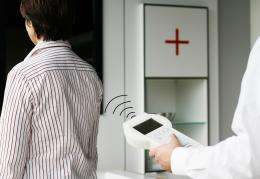Using radio signals to prevent heart failure

Increased pressure in the heart is a warning sign - it may indicate heart failure. In the future, a battery-less miniature sensor implanted in a patient’s heart could be used to transmit on-demand cardiac pressure readings to their attending physician.
Different parts of the heart have different functions: The right side keeps the pulmonary circulation going, while the left pumps oxygen-enriched blood around the body. Increased pressure in the left chamber of the heart may be an indication of cardiac insufficiency or heart failure.
Until now, coronary angiography has been the traditional method of measuring this pressure. In this procedure, the investigating doctor punctures an artery in the groin and inserts a catheter, then injects a contrast medium which enables him to trace the catheter’s path to the heart on an X-ray screen and monitor cardiac activity. The patient lies quietly and unmoving in bed for the duration, and the pressure in the heart chamber can only be measured over that same period of time.
Clearly, longer-term measurements under various loading conditions would be considerably more informative, and now an innovative pressure sensor system promises to allow precisely that.
The Duisburg-based (Germany) Fraunhofer Institute for Microelectronic Circuits and Systems IMS will be exhibiting the system at the electronica trade fair in Munich, from November 9 through 12, 2010. The new pressure sensor delivers up to 200 measurements a second. For the sake of comparison, the heart of an averagely fit adult will beat three to four times a second under extreme loading. “This means even the smallest malfunction of the heart will be revealed. And particularly in the initial stages of illness, these tend to occur only sporadically,” says Dr. Gerd vom Bögel, group manager at the IMS.
The rod-shaped sensor, which is 2 millimeters by 10 millimeters in size, is attached to the wall of the heart with the aid of a catheter. When the catheter is withdrawn, the sensor remains in situ. If necessary, it will deliver pressure data over a period of several months. That said, it transmits solely on demand: Just like a passive RFID transponder, the sensor only operates when its associated reader device supplies it with energy - via an inductive antenna coupling. The sensor does not require a battery, rechargeable or otherwise. An output of 90 microwatts is sufficient to take a pressure measurement and transmit the reading across a distance of up to 40 centimeters. Since the sensor and its integrated antenna can only be positioned longitudinally in the heart, it must be read laterally, on the side of the ribcage. In order to minimize attenuation of the signal by bone, body tissues and liquids, the system transmits in the 10 MHz range. It is encapsulated in a biocompatible polymer shell which, unlike metal, does not block radio waves, but allows them to pass.
The Duisberg researchers have also developed a new low-loss transmission process, as vom Bögel explains: “The load modulation that is used for passive RFID transponders deliberately destroys a portion of the transmitted energy in order to encode the transmitted information. We use that portion of energy, which is usually lost, as transmission energy, and thus achieve significantly longer ranges.”
This new form of frequency conversion could also improve the performance of other RFID systems operating in the 10 MHz range - for example in the logistics sphere, when it comes to automatic identification and tracking of gas canisters or hazardous liquid containers. But vom Bögel cautions: “At the moment, we’re concentrating solely on medical applications.” In order to make their heart pressure sensor even more efficient, the IMS researchers now want to optimize the design of the chip which contains both the sensor and the radio unit.




















